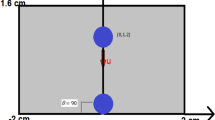The mechanism of formation of secondary drops due to collision of a drop with a fixed and a moving thin liquid film is studied. The total volume of secondary drops is shown to depend on the thickness and velocity of the liquid layer and on the slope of the tray. However, the experiments performed failed to prove an unambiguous dependence of the total volume and disperse composition of the secondary drops on each of the parameters of the problem separately.
Similar content being viewed by others
References
V. G. Sister and Yu. V. Martynov, Principles of Raising Efficiency of Heat and Mass Exchange Processes [in Russian], Izd. N. Bochkareva, Kaluga (1998), p. 508.
V. G. Sister, O. A. Eliseeva, and A. K. Lednev, “Mechanism of collision interaction with a liquid surface,” Khim. Neftegaz. Mashinostr., No. 5, 11–12 (2009).
Author information
Authors and Affiliations
Additional information
Translated from Khimicheskoe i Neftegazovoe Mashinostroenie, Vol. 45, No. 8, pp. 16–18, August, 2009.
Rights and permissions
About this article
Cite this article
Sister, V.G., Eliseeva, O.A. & Lednev, A.K. Formation of secondary drops upon collision of a drop with a liquid surface. Chem Petrol Eng 45, 473 (2009). https://doi.org/10.1007/s10556-009-9212-1
Published:
DOI: https://doi.org/10.1007/s10556-009-9212-1




